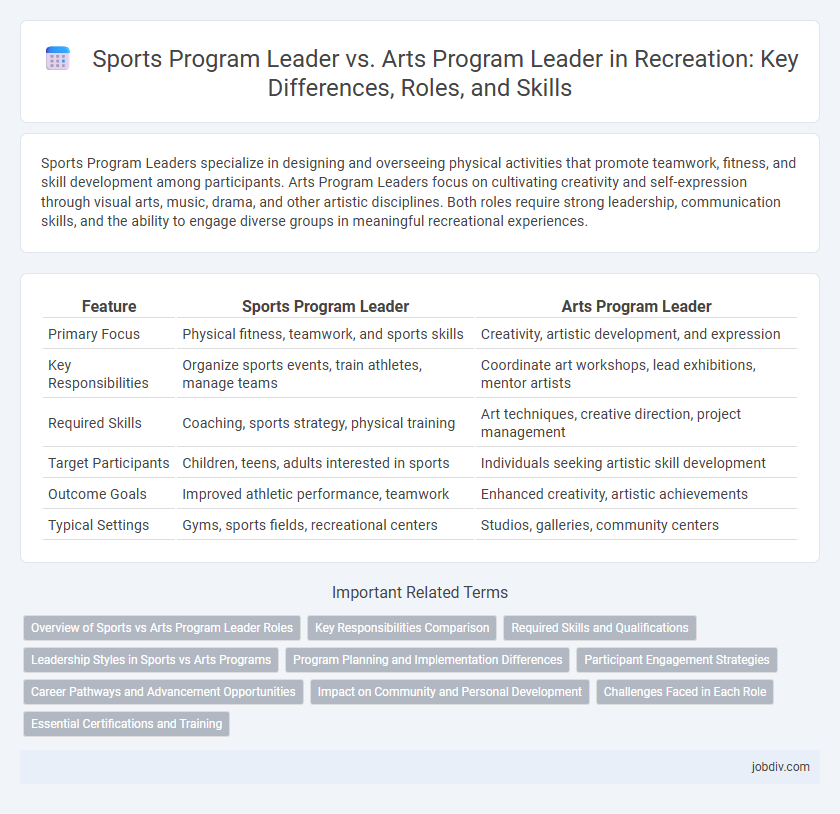Sports Program Leaders specialize in designing and overseeing physical activities that promote teamwork, fitness, and skill development among participants. Arts Program Leaders focus on cultivating creativity and self-expression through visual arts, music, drama, and other artistic disciplines. Both roles require strong leadership, communication skills, and the ability to engage diverse groups in meaningful recreational experiences.
Table of Comparison
| Feature | Sports Program Leader | Arts Program Leader |
|---|---|---|
| Primary Focus | Physical fitness, teamwork, and sports skills | Creativity, artistic development, and expression |
| Key Responsibilities | Organize sports events, train athletes, manage teams | Coordinate art workshops, lead exhibitions, mentor artists |
| Required Skills | Coaching, sports strategy, physical training | Art techniques, creative direction, project management |
| Target Participants | Children, teens, adults interested in sports | Individuals seeking artistic skill development |
| Outcome Goals | Improved athletic performance, teamwork | Enhanced creativity, artistic achievements |
| Typical Settings | Gyms, sports fields, recreational centers | Studios, galleries, community centers |
Overview of Sports vs Arts Program Leader Roles
Sports Program Leaders coordinate athletic activities, manage team training schedules, and ensure safety protocols during physical events. Arts Program Leaders develop creative workshops, oversee artistic projects, and cultivate environments that foster cultural expression and skill development. Both roles require strong leadership, organization, and communication skills but differ in their focus on physical performance versus artistic creativity.
Key Responsibilities Comparison
Sports Program Leaders oversee the planning, coordination, and execution of athletic activities, emphasizing physical fitness, team-building, and skill development through structured sports events and training sessions. Arts Program Leaders manage creative workshops, performances, and exhibitions, fostering artistic expression, cultural appreciation, and talent cultivation across disciplines such as visual arts, music, and theater. Both roles require leadership, program evaluation, and participant engagement but differ mainly by their focus on physical activity versus artistic creativity.
Required Skills and Qualifications
Sports Program Leaders require expertise in physical education, team management, and injury prevention, along with certifications such as CPR and first aid. Arts Program Leaders need proficiency in creative disciplines, curriculum development, and communication skills, often holding degrees in fine arts or arts administration. Both roles benefit from strong leadership, organizational abilities, and experience in program planning and community engagement.
Leadership Styles in Sports vs Arts Programs
Sports Program Leaders emphasize transformational and authoritative leadership, fostering team cohesion and goal-oriented performance through clear direction and motivation. Arts Program Leaders adopt a participative and facilitative leadership style, encouraging creativity, collaboration, and individual expression within the group. These contrasting approaches reflect the dynamic, competitive nature of sports versus the expressive, explorative environment of arts programs.
Program Planning and Implementation Differences
Sports Program Leaders specialize in organizing structured physical activities, emphasizing safety protocols, team coordination, and skill development tailored to various age groups. Arts Program Leaders focus on creative workshop design, material procurement, and fostering individual expression through diverse mediums such as painting, music, and dance. Both roles require strategic planning and participant engagement but differ in activity nature, resource management, and outcome evaluation methods.
Participant Engagement Strategies
Sports Program Leaders enhance participant engagement by incorporating dynamic drills, team-building exercises, and competitive games tailored to varying skill levels, fostering motivation and physical activity. Arts Program Leaders engage participants through interactive workshops, creative expression opportunities, and personalized feedback, encouraging emotional connection and artistic growth. Both roles utilize adaptive communication techniques and culturally relevant content to maintain high participation and satisfaction rates.
Career Pathways and Advancement Opportunities
Sports Program Leaders often advance through certifications in coaching, fitness training, and sports management, leveraging experience in team leadership and event coordination to move into roles such as Athletic Director or Recreation Manager. Arts Program Leaders typically progress by enhancing skills in arts administration, grant writing, and community engagement, aiming for positions like Arts Director or Cultural Program Coordinator. Both career paths offer opportunities for specialization and leadership within educational institutions, community centers, and professional organizations.
Impact on Community and Personal Development
Sports Program Leaders foster physical health, teamwork, and leadership skills by organizing activities that engage diverse age groups and skill levels, significantly enhancing community cohesion and reducing youth delinquency. Arts Program Leaders stimulate creativity, cultural awareness, and emotional expression through programs that promote inclusion and personal identity development, enriching community cultural fabric. Both roles contribute uniquely to personal growth and social well-being, with sports emphasizing physical and social dynamics, while arts prioritize emotional and cultural development.
Challenges Faced in Each Role
Sports Program Leaders face challenges such as managing diverse skill levels, ensuring participant safety during physical activities, and coordinating resources for competitive events. Arts Program Leaders encounter difficulties in fostering creativity within budget constraints, sourcing diverse materials, and engaging participants with varying artistic backgrounds. Both roles require strong communication skills and adaptability to address individual needs and promote inclusive environments.
Essential Certifications and Training
Sports Program Leaders require certifications such as CPR, First Aid, and coaching licenses specific to their sport to ensure participant safety and effective skill development. Arts Program Leaders often need credentials in art education, workshop facilitation, and sometimes specialized certifications in areas like dance or music therapy. Both roles benefit from training in leadership, risk management, and child protection to optimize program delivery and participant engagement.
Sports Program Leader vs Arts Program Leader Infographic

 jobdiv.com
jobdiv.com